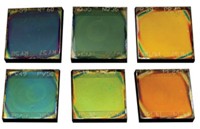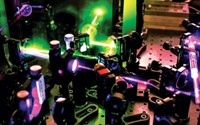Advertisement
Grab your lab coat. Let's get started
Welcome!
Welcome!
Create an account below to get 6 C&EN articles per month, receive newsletters and more - all free.
It seems this is your first time logging in online. Please enter the following information to continue.
As an ACS member you automatically get access to this site. All we need is few more details to create your reading experience.
Not you? Sign in with a different account.
Not you? Sign in with a different account.
ERROR 1
ERROR 1
ERROR 2
ERROR 2
ERROR 2
ERROR 2
ERROR 2
Password and Confirm password must match.
If you have an ACS member number, please enter it here so we can link this account to your membership. (optional)
ERROR 2
ACS values your privacy. By submitting your information, you are gaining access to C&EN and subscribing to our weekly newsletter. We use the information you provide to make your reading experience better, and we will never sell your data to third party members.
Materials
Inorganic LEDs flex and shine white
Gallium nitride nanowires promise bendable, longer-lasting, white light-emitting diodes
by Neil Savage
April 7, 2016

Flexible light-emitting diodes allow designers to create wearable display screens, curved or flexible television screens, bendable biomedical devices, and any other nonflat light source one might desire. Today, the best technology for flexible light sources is organic LEDs. But OLEDs have relatively short lifetimes, and bright ones aren’t very efficient, especially the blue-emitting ones that are used to make white LEDs, a necessary component of full-color displays. Now a group of researchers has shown the potential to overcome those limitations by building flexible white LEDs out of inorganic nanowires instead (ACS Photonics 2016, DOI: 10.1021/acsphotonics.5b00696).

Blue LEDs offer one of the best ways to create white light. High-energy blue or ultraviolet photons are used to stimulate a phosphor, which in turn emits lower energy photons that can mix either with the blue photons or with each other to produce white light.
The team created the nanowires out of gallium nitride, an inorganic semiconductor that emits blue light efficiently, says Joël Eymery, a researcher at France’s Alternative Energies & Atomic Energy Commission. Eymery, along with Maria Tchernycheva of the University of Paris, Saclay, and colleagues, coated the nanowires with a commercially available phosphor of yttrium aluminum garnet doped with cerium, which absorbed the blue output from the nanowires and emitted white light.
But first, the researchers grew the nanowires on a sapphire substrate using metal-organic chemical vapor deposition. On the surface of each wire they deposited layers of indium-gallium-nitride to trap electrons and cause the light emission, then covered the wires in a GaN shell. The team embedded the resulting wires in polydimethylsiloxane laced with the phosphor, then peeled the polymer full of nanowires off the substrate. They topped the material with a silver nanowire mesh to act as a transparent electrode, and a placed a thin metal foil on the bottom to complete the circuit.
The resulting LEDs, approximately 5 by 6 mm, could be bent to a radius of 5 mm without any reduction in performance. The devices had an external quantum efficiency—a measure of the number of electrons converted to photons and emitted—of 9.3%. That’s low for an LED, but Eymery says they can improve the efficiency by using other phosphors, changing the dopants within the phosphors, or experimenting with other semiconductors. “The applications for this flexible stuff will not be for the general lighting applications,” he says, so the efficiency would not need to be as high as other LEDs to be commercializable. On the other hand, the nanowire LEDs should have a stable lifetime at least four times that of an OLED, he says.
These are “very exciting results,” says Zetian Mi, an electrical engineer at McGill University. “Compared to organic devices, inorganic devices are much more robust and stable and can potentially exhibit much better efficiency,” Mi says.
Keon Jae Lee, a materials scientist at the Korea Advanced Institute of Science and Technology, says the LEDs need much development to be competitive with OLEDs, but adds that “if nanowire LEDs can overcome the present problems, they will be interesting alternative technology.”





Join the conversation
Contact the reporter
Submit a Letter to the Editor for publication
Engage with us on Twitter